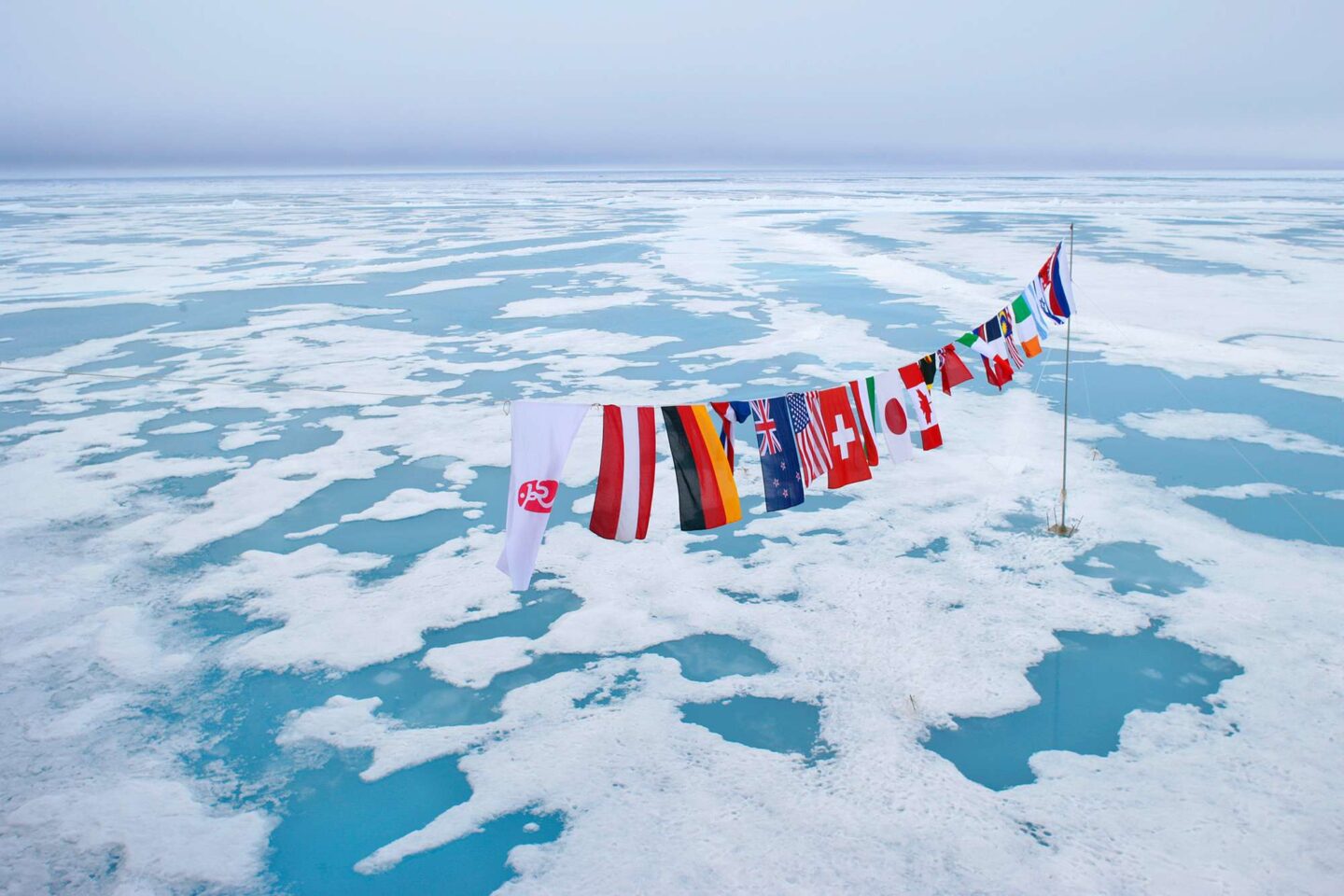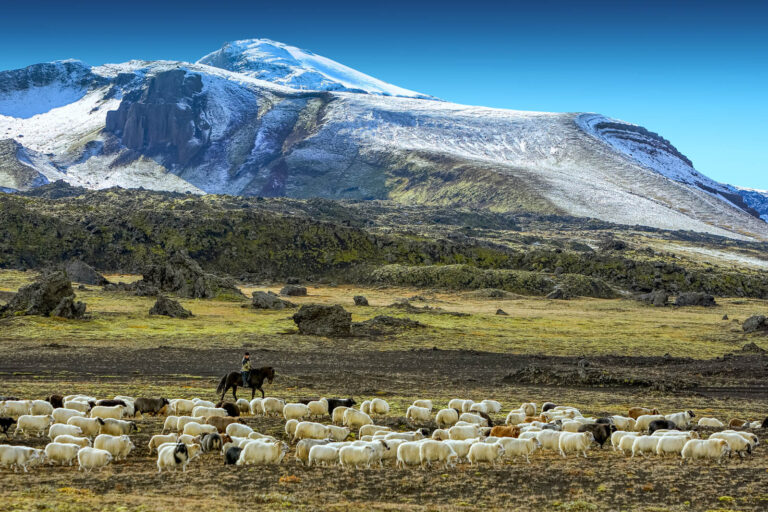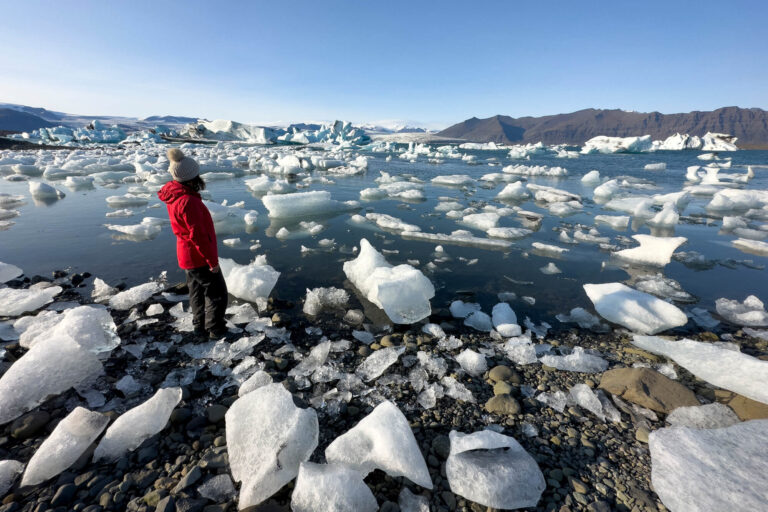
“I’m on top of the world!” – An expression many people use, but rarely is it used in the literal sense!
To be able to say “I am standing at the top of the world” has, until recently, been a privilege only a few hardy explorers could hope to have. But not any more… our client, Joanne Stone, tells her tale of adventure to the North Pole…
“Standing at the North Pole was something I’d dreamt of doing for many years – until a casual online search last year brought up the passenger voyages of a Russian icebreaker to 90 degrees North and the itinerary of Discover the World.”
No longer, it seemed, did one have to be super-fit and able to with-stand -50°C, nor have the skills to fish for ones dinner or haul it behind one on a sledge. Here was, if not a luxury cruise ship, certainly a comfortable, expertly crewed and welcoming vessel, whose novelty was increased by the fact she is nuclear powered – which helps the green credentials.
The thought of the photo opportunities, especially of a voyage that included the chance of viewing a total solar eclipse, persuaded my husband that investing in memories rather than our pension was a good idea. So, armed with a shiny Russian visa, lots of polo necks and warm socks we boarded the plane for Helsinki.
“There we joined a group of just over one hundred others, who came in the main from Britain and North America, although there were at least 10 nationalities on board. A US company, Quark, ran the expedition, although the leaders, lecturers and hotel staff were all European and English was the universal language.”
The ages of the passengers ranged from 12 to over 80, although the majority were in their 40s, 50s and 60s. There were families, couples, fathers and sons, regular single explorers and first time adventurers. The easiest way to categorise us was to say there were no categories!
Embarking on the 50 Years of Victory
We were joined in Helsinki by one of the expedition staff, who checked our paperwork (one poor traveller hadn’t got a visa and his trip ended there) and gave us the travel details for the next day. These included a scarily early start to get the flight to Murmansk, two hours at the airport as our papers were thoroughly checked by immigration staff, a tour of the city (in unseasonably warm weather) including lunch and another hour to get the three coaches into the Nuclear Port, where the ship was berthed.
The first sight of 50 Years of Victory was memorable. She was going to be our home for the next two weeks, but homely is not a word to describe such a vessel. She is the largest icebreaker ever built and is a working ship for nine months of the year, clearing lanes for merchant vessels along the North-East passage. Having only started taking expeditions this year, ours was to be her third trip with passengers to the Pole.
Massive, rugged, muscular, dependable, with a black hull and orange/red superstructure, she would never win awards for the most beautiful passenger ship afloat but she looked incredibly impressive. And over the next 14 days she proved again and again the old adage ‘handsome is as handsome does’ as she broke through ice more than two metres thick with gusto. Outside is all workman like steel, with cranes, domes, hoists, lifeboats (not steel!) and spare propeller blades eight feet tall bolted to the decks. Apparently they can change a blade at sea using just one diver… The very Russian helicopter occupies the back quarter of one deck and unless it is flying we could access all deck areas whenever we wanted.
“This welcome extended to almost everywhere inside, where not even the bridge was off-limits – except as we actually approached the Pole, probably to stop all of us trying to get photos of the ship’s GPS at once! The only place we were specifically excluded from was the nuclear section, although we were able to visit even there on the engine room tour.
Inside there is wood veneer, but this is no Titanic with panelling and curlicues, everything there fulfils a role. There is a lift (although it is turned off when the ship is breaking ice) and normal stairs to most places, but there are also companionways and very high thresholds to some entrances, which resemble the watertight doors of submarines.
Life onboard
We were allocated cabins on the main decks that are used by officers and temporary crew during the winter months. As with the rest of the ship they are comfortable and functional rather than luxurious, with small en suites (and slightly odd toilets!) a desk and television. Our mini-suite was larger than the regular cabins but not hugely different. Our only disappointment was the bed. We had assumed that there would be a double bed but there was a single berth and a second, small double bed, made from the convertible sofa. Other than that the accommodation was as good and frequently better than one might expect from an expedition environment.
“In particular the food left us all astounded. Every day there was a full buffet breakfast, followed by a three-course lunch and dinner each with three choices for main course. Lobster, steak, caviar and sinful desserts featured regularly and the food was fresh and excellently cooked. No amount of gym time or tai-chi (offered by one of the lecturers) would burn off the daily calories if, like us, the charming Russian waitresses persuading us that it would be a shame to miss a course!”
The first days as sea involved some admin, with group number allocations, safety briefings – the one involving the survival suit was entertainment in itself – and a lifeboat drill. Then we settled into a routine (as much as there ever was one) of lectures, an engine room tour (where my husband broke his foot, but that’s another story) and the first helicopter flights. We were invited in groups to meet the Captain, who’s English was almost good enough not to need a translator (although there always was one on hand for him and the engine room tour) and he was open, friendly and obviously very capable.
Together with the expedition leader and deputy the expedition team had two historians, a biologist, a geologist, an ornithologist, a BBC natural history film-maker and, because of the eclipse, two astronomers, all of whom helped our understanding of the Arctic. They also acted as guides, safety officers and social secretaries, always there to help with questions, eating with us and generally making the whole experience very relaxed and intimate. There were also three armed Russians who made sure Polar bears didn’t eat us when we were off the ship, but we didn’t socialise with them much!!
By day three we were breaking ice near Franz Josef Land. We had a stunning sighting of a mother Polar bear and two cubs, being followed by a male early on day 4 (all sightings, interesting observations and lectures were announced over the tannoy) and a BBQ with Neptune to welcome us to the Arctic Circle that night.
90° North
Our arrival at the Pole actually took place in the middle of the night (about 2am) but with 24 hours of daylight it really didn’t seem to matter. Champagne and canapés, together with lots of photos of GPS gadgets and hand made signs were followed by a few hours of sleep while the crew (did they ever sleep?!) manouveured the ship into a patch of ice large and strong enough to take the helicopter for our day at the Pole.
Before I went I hadn’t really appreciated that my time directly on 90° North would be short – a matter of a few seconds. Since the ice moves continuously the few square metres that are at the Pole at 2am have moved off by 2:01. However, our day of celebration was as close as made no difference.
“We spent the day on the ice, first for the iconic circle photo, then, while some walked the vast ice floes, others took a Polar plunge. The expedition leader started us off, and having seen him survive more than half of us jumped, dived and, most bravely, walked down the steps into the clearest, bluest, coldest water we’ll ever swim in. The shot of vodka afterwards was most welcome even to a teetotal, and the only part it didn’t reach was the toes!”
The feelings as I stood at the Pole are difficult to sum up. But they included awe at the vastness of the ice-scape, elation that we had made it and gratitude to the ship and her crew, disbelief that people could ever have reached here on foot, and a sense of wonder at the silence and beauty. And these and many other feelings were tinged with a sense of foreboding that this vast and pristine wilderness may not remain for much longer.
Our return involved a visit to several sites on Franz Josef Land, with the helicopter ferrying groups to places of historical significance. The lateness of the season meant the sea ice had all but gone and bear sightings were therefore rare, but the historians kept us engaged and even the sighting of bear dung caused excitement.
Chasing the eclipse
Finally, we headed for Novaya Zemlya and the eclipse. Having been blessed with extraordinary weather at the Pole it seemed greedy to expect the same for this, and indeed the sky looked far from promising at the start of the day. But with the moon eating chunks out of the sun visible through a layer of cloud, and a tantalising patch of sun on the sea in sight, the captain turned the ship and ‘put his foot down’ as we sped at over 20 knots towards the light. It made what was already an extraordinary experience very dramatic, and while for seasoned eclipse chasers it was probably rather scary for us novices it was an added adventure. With impeccable timing the diamond ring appeared from behind the last cloud as we reached open sky and the total eclipse was enjoyed by all of us including, happily, the crew.
Not pausing in his dash for home the Captain brought us back to Murmansk in plenty of time for the final dinner, presentation of photos and auction, and after many promises to stay in touch and last minute photos we spent our last night on board and disembarked early for the rather quicker return journey to Helsinki.
“So what memories will stay ingrained when thinking of the Pole? Silence; vast expanses of pristine ice glowing blue from inside; the adrenaline rush as the sighting of polar bears was announced; the chill of a dip in the Arctic Ocean; the humour and knowledge of the expedition team; the dash to the clear sky for the eclipse; the obvious thrill of the passengers as the ship first broke ice; moments of drama as the ship manoeuvred near land in closing mist to allow the helicopter to pick up passengers; ‘swimming pools’ on the ice floes; and, uniquely for us, the good natured resignation that my husband, with a broken foot on day two, moved around the ship and ice on Quark crutches…”
Joanne Stone
North Pole Voyage, July 2008
Feeling Inspired?
For the ultimate bucket-list experience, discover the North Pole on a fabulous adventure. Contact our team.






 Instagram
Instagram
 Facebook
Facebook
 YouTube
YouTube